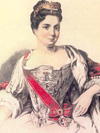Autographs of Russian emperor and empresses
Samples of signatures are provided by the State Historical Museum.
Cesarevitch Alexei Nikolayevich
(1904-1918)
Cesarevitch, heir to the Russian emperor throne, the fifth child and the only son of Nikolai II and Alexandra Fyodorovna. He was shot together with the whole emperor family in 1918. He was canonized as a martyr.
Emperor Nikolai II
(1868-1918)
Last of the Emperors of the Romanov dynasty, the fourteenth All-Russian Emperor (1894-1917). His reign fell on the period of sharp aggravation of political struggle in the country and international situation. He was shot by Bolsheviks together with his family. He was canonized as a martyr.
Grand Duke Sergei Alexandrovich
(1857-1905)
Fifth son of Alexander II, spouse of righteous martyr Grand Duchess Elizaveta Fyodorovna. Participant in the Russian-Turkish war of 1887-1878, starting from 1896 – Commander-in-Chief of the Moscow Military District (lieutenant general). He was a president, chairman and member of numerous scientific societies and charitable institutions.
Emperor Alexander III
(1845-1894)
Thirteenth All-Russian Emperor (1881-1894). In historiography he received a special epithet - Peacemaker. He carried out the course of “counter reforms” and issued the Edict about construction of the Great Siberian Way (Trans-Siberian Railway). He was the last but one Emperor of Russia.
Emperor Alexander II
(1818-1881)
Twelfth All-Russian Emperor (1855-1881). He abolished serfdom and carried out a number of reforms – zemstvo, judicial, military and others. He is known in history as Alexander II Liberator. He died in the result of a terrorist attack in the day when he was going to sign the Constitution.
Emperor Nikolai I
(1796-1855)
Eleventh All-Russian Emperor (1825-1855). His reign was marked with the uprising of the Decembrists on December 14, 1825, Caucasian War (1817-1864), Russian-Persian War (1826-1828), Russian-Turkish War (1828-1829) and Crimean War (1853-1856).
Emperor Alexander I
(1777-1825)
Tenth All-Russian Emperor (1801-1825). In historiography he received a special epithet – Blessed. In the beginning of his reign he carried out moderate liberal reforms. After the Patriotic War of 1812, in 1813-1814, he headed the anti-French coalition of European states. He was one of the heads of the Vienna Congress (1814-1815) and organizers of the Holly Alliance.
Emperor Pavel I
(1754-1801)
Ninth All-Russian Emperor (1796-1801). He planned to establish in Russia, under the aegis of autocracy, strict lawful governance, restriction of rights of nobility, introduction of rigorous discipline. His foreign and home policies were characterized with inconsistency.
Empress Ekaterina II
(1729-1796)
Eighth All-Russian Empress (1762-1796). The period of her reign was called the “Golden Age” of the Russian Empire, and the Senate presented Ekaterina II with the epithet of “the Wise Great Mother of the Fatherland”. She was the only Russian ruler woman named “the Great” similar to Peter I.
Empress Elizaveta Petrovna
(1709-1762)
Russian Empress, daughter of Peter I the Great and Martha Skavronskaya (future Ekaterina I). After the marriage of her parents had the title of the Princess Royal. In the period of her reign, in 1755 the Moscow University was opened, the Academy of Arts was established, outstanding cultural monuments were created. She promoted reinstatement of the role of the Senate, abolished death penalty and eliminated internal country customs.
Empress Anna Ioannovna
(1693-1740)
Fourth All-Russian Empress (1730-1740). The second daughter of Ivan V (joint ruler of Peter I) from Praskovya Fyodorovna. After the death of Peter II she was invited to the Russian throne by the Supreme Privy Council as a sovereign with restricted powers but she took all the power after disbanding the Council. The period of her reign was named “Bironovshchina” after her minion Ernst-Iogan Biron.
Empress Ekaterina I
(1684-1727)
Russian Empress from 1721 as the spouse of reigning Emperor Peter I the Great. After the Emperor’s death she was crowned to the throne. In 1725-1727 she was second All-Russian Empress with actual governance by Alexander Danilovich Menshikov. Mother of Empress Elizaveta Petrovna.
Prince Alexander Danilovich Menshikov
(1673-1729)
Russian statesman and military leader, associate and minion of Peter I, after his death he was unofficial ruler of Russia in 1725-1728. He received the tile of His Serene Highness Prince and he was the only Russian nobleman who received the title of duke. He was the Prince of the Roman Empire, first member of the Supreme Privy Council of the Russian Empire, first Russian senator. Field-Marshal-General, during the reign of Peter II – Generalissimo of navy and land forces.
Emperor Peter I
(1672-1725)
Peter I Alexeyevich was the thirteenth tsar of Russia and the first Emperor of the Russian Empire. He in known in history as Peter the Great. One of the most outstanding statesmen in world history, who determined directions of development of Russia in the XVIIIth century. By today only few samples of handwriting of the great Emperor have survived.
Tsar Mikhail Fyodorovich
(1596-1645)
Statesman, first Russian tsar of the Romanov dynasty, founder of the dynasty. At the age of 16 he was elected for reign by the Assembly of the Land, he was crowned on July 11, 1613. During the period of his reign the Stolbov Peace Treaty was signed ending the Russian-Swedish War, the war with Poland was ended (1634) and relations with foreign states were resumed.
Calligraphy — the written beauty of feelings.
































